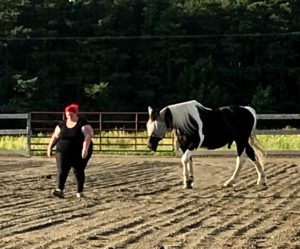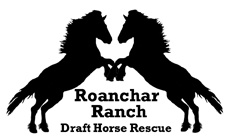Leadership, Team Building, and Personal Development
 Interacting with horses is a unique experience because horses have the keen ability to detect intention and authenticity in people and are known to “mirror” behaviors they are picking up from others. It requires participants to be pro-active, authentic, creative, and practice self-awareness.
Interacting with horses is a unique experience because horses have the keen ability to detect intention and authenticity in people and are known to “mirror” behaviors they are picking up from others. It requires participants to be pro-active, authentic, creative, and practice self-awareness.
Horses have a unique ability to pick up on what people are feeling by reading and reacting to people’s body language. Participants, unaware that their body language reflects their insecurity, sometimes complain, “This horse is difficult and uncooperative. He doesn’t like me,” However, when they change their body language, the horses become more interested. Horses are insightful teachers because they relinquish their herd position willingly to those who convey genuine trust, respect, and confidence.
Horses are very much like humans in that they are social animals. They have defined roles within their herds and have distinct personalities, attitudes and moods. An approach that seems to work with one horse does not necessarily work with another. Participants learn to be aware of the horse’s body language and change their approach accordingly. Accomplishing a task with a horse successfully increases participants’ confidence and provides an opportunity to transfer the learned skills to problem-solving and overcoming intimidating and challenging situations in life.
The Driving Change Program will help you to:
- communicate more effectively;
- build stronger and more satisfying relationships;
- feel better about yourself and dramatically increase your self-confidence;
- be more assertive;
- eradicate limiting beliefs that block your progress;
- enhance your problem-solving skills; and
- thrive on change and challenges;
Who can benefit from the Driving Change Program:
- School/Youth Groups
- Families
- Organizations/Companies
- Retreats/Workshops
Examples of Activities (Riding horses is NOT part of any of the activities)
- Participants are instructed to move a horse over a jump placed in the arena without physically touching the horse, without using halters or lead ropes, without bribing, and without any verbal communication. Participants learn that if they want to change the horse’s behavior, they have to change their own behavior, thoughts and feelings.
- An obstacle course is built with various turns and twists and is dotted with hay bales, buckets of grain, heaps of carrots and other potentially attractive items to the horse. The participants must then lead their horse through the course without allowing the horse to eat anything, leave the course or knock anything over. Each participant must hold a lead rope with only one hand at the very end of the rope while staying outside the course.
- Three participants are tasked with haltering a horse. The participants have their arms linked, standing side by side. The middle person is not able to use their hands and must tell the person on their right and left (acting as the center person’s right and left hands) what to do. The participants on either side of the middle person can only use their free hand. This is a great exercise in communication and listening skills.
Learn More
Each session is designed to meet the needs of the group, organization, or individual. We meet with you prior to the event to learn about your goals and how we will work together to accomplish them. Your experience can be a stand-alone session or return for sequential sessions and build on your group’s initial learning.
